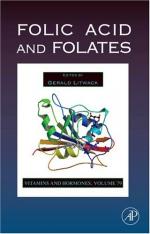|
This section contains 365 words (approx. 2 pages at 300 words per page) |
Folic acid is a member of the vitamin B family of compounds. It plays an important role in the synthesis of methionine, one of the amino acids, and in the formation of thymine and purine, components of the nucleic acids which are essential elements of all cells.
Because the blood's red and white cells appear to be particularly sensitive to a folic acid deficiency, blood disorders--such as megaloblastic anemia and sprue--are an early and important sign that the vitamin may be lacking. In the 1930s and 1940s this fact helped attract attention to a newly-discovered substance. The new substance, water-soluble and apparently similar to B vitamins, not only acted as a growth factor in animals but also appeared to reverse certain anemias.
Studied by investigators around the world, the new substance received a number of different names. Lucy Wills and her coworkers, for instance, described an antianemic "Wills Factor" that seemed to be present both in a yeast-based tonic and in crude liver extracts. Paul Louis Day and his associates discovered a "vitamin M" in dried brewer's yeast that corrected anemia in monkeys. A third research group found a " Vitamin Bc" that staved off anemia in chicks.
Folic acid received its official name, however, in 1941. In that year, Henry K. Mitchell (b.1913) and two associates found that the major source of the compound's extraction was green leafy vegetables. Therefore, they named it for folium, the Latin word for leaf.
In 1945, Robert Angier (1917-) and his coworkers at Lederle Laboratories identified the structure of folic acid and synthesized it. By so doing, they established the fact that a number of variously named antianemic compounds, frequently reported in the medical literature, were one and the same.
Folic acid has been found to be an important part of a healthy diet. It has been found that when consumed in high enough amounts by women, folic acid will reduce the risk of diseases such as spina bifida. For this reason, the United States Food & Drug Administration requires that enriched breads, flours, pastas and rice have folic acid included. Data has also been found that folic acid can lower the risk of cardiovascular disease in women.
|
This section contains 365 words (approx. 2 pages at 300 words per page) |


